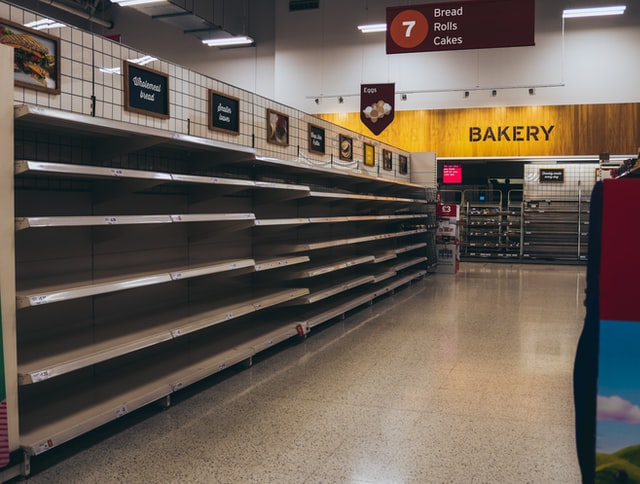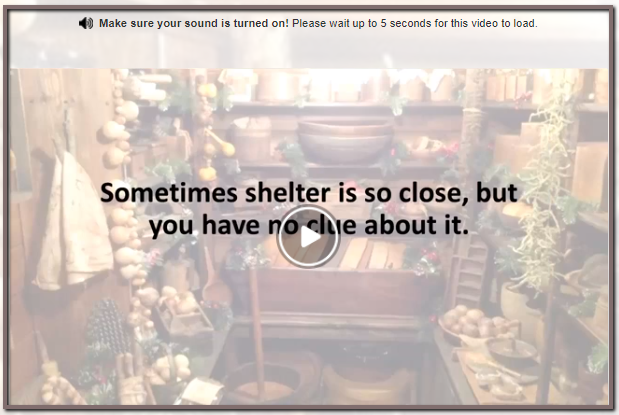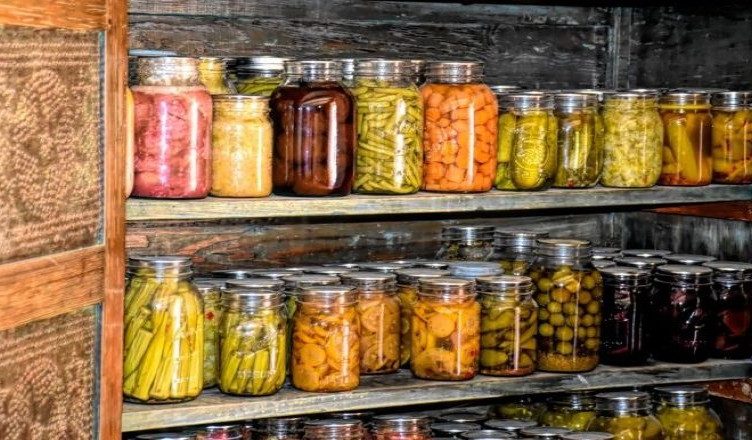When you start to consider prepping, one of the first things you need to start prepping for is your prepper food storage. Beyond the basics, many of us look at this increased focus on food capacity as our survival pantry. Simply put, food is one essential you need to live, and your family must have a sufficient supply of food on hand to keep you fed should any emergency strike.
Because of our just-in-time supply chain model, most grocery stores do not have more than 3 days’ worth of food stocked. The shortcomings with JIT were clearly evident during the early days of Coronavirus.
In any type of emergency or disaster situation, the store shelves are cleaned quickly, and they aren’t restocked immediately. The empty shelves themselves start to panic shoppers who buy more than they need. That’s why stocking a survival pantry should be one of the first prepping items you work on.
What are the best survival foods?

Before running to the grocery or big box store and filling a cart or two with food items you may think are perfect for your survival pantry, it helps to think about what qualities or attributes make the best survival foods in the first place. It’s a fairly basic set of requirements and I’m sure you will see the logic in this list
- Foods that your family already eats – This is one of the prepper food storage mistakes we will talk about later in the article. One time when I first started to build my food storage out, I purchased a case of canned mushrooms because they were a good deal. Five years past the expiration date we threw them out. My wife never cooked with canned mushrooms. They sat there unused the entire time so that was a fail on my part. Part of what makes this survival pantry checklist work is that you should be rotating these foods into your normal routine so they never expire. If you don’t like a certain item, that is really difficult to do.
- Foods that have a long shelf life – Most canned food is a great candidate for this requirement but others are shelf-stable on their own like beans and rice if kept in the right conditions.
- Foods that are nutritionally packed – You don’t want to store a lot of “junk food” that tastes good. You will need higher-quality nutrition if your body is under stress and overworked. Comfort items are fine and recommended of course but should not be a significant portion of your survival pantry inventory.
- Foods that do not require refrigeration – This should be obvious but you don’t want a power outage ruining all of your food.
- Foods that are easy to prepare with primitive cooking means – Think no stove or microwave. Everything on the list below can be cooked in my Dutch oven over a fire or camping stove with usually nothing more than added water.
Survival Pantry List
Starting our survival pantry is a fairly straightforward project and can easily be done in conjunction with your regular shopping. If you don’t have the funds to purchase everything at one time, that’s fine. Pick one area and slowly build your food storage over time.

The list below is fairly inexpensive but that’s relative I know. Some of you can do 10 times the amounts below. Others will struggle. You know what is best for you and remember to keep making forward progress is the goal. I also purchased all of this at a big box store but you can get everything in a regular grocery store.
Survival Pantry Staples
Grains – Rice
First off, buy a 50lb. bag of rice. These contain 504 servings and I don’t know too many people who won’t eat rice. It is simple to cook and store for years if you keep it cool and dry. One bag like this at Sam’s or Costco costs about $25 now. OR you can buy something like the Augason Farms Long Grain White Rice Emergency Food Storage 24 Pound Pail and keep that rice good for a much longer time. They advertise 30 years.
Oatmeal
Good old-fashioned oatmeal is simple to cook and store. A normal container has 30 servings each so purchase about 4 of these and your family will not starve for breakfast. At $2 each that is about $8 for breakfast for a month for a family of four. Could you exchange Pop-tarts? Maybe, but I find oatmeal more filling and less likely to be snacked on.
Beans
Next, buy some bags of dry beans. This can be any kind of beans you like and get a few varieties if you like. This will check off the Beans part of your Beans, Bullets, and Band-Aids list. A good size bag is about $5 and makes 126 servings. Buy two if you think your family would like them.
Canned meat
Cans are great for fruits and vegetables and anyone can find something they will eat. For canned meat, I recommend tuna or chicken because it tastes a heck of a lot better than Spam and you can easily mix that into your rice.
For the meat, you will need approximately 35 cans. Each can have about 3 servings and this will be the costliest survival pantry items to purchase, but they last over a year usually and your family probably eats chicken or tuna on a semi-regular basis anyway so restocking this should be simple.
Alternate – TVP (Textured Vegetable Protein)
The easiest way for most people to have their own renewable source of protein is by raising chickens and rabbits. Chickens pull double duty as egg layers and a source of meat. Rabbits are prolific at reproducing. That’s why there are several sayings that have rabbits at the heart of the pun… Rabbits are easy to raise and don’t take up much room.
Canned Vegetables
You will need about 40 cans of vegetables and again this can be whatever your family will eat. Expect to pay around a dollar each so $40 for veggies to last your family a month.
I would also add things like diced tomatoes, broths, and other canned items you use to supplement your food recipes.
Canned Fruit
Simple fruits that your family will eat. These can even be fruit cocktail if that is the safest thing. At Costco, they have the #10 cans of fruit like pears or apple slices and each of these has 25 servings. 5 of these will cost about $25 and give your family a daily dose of fruit. I would caution against the #10 cans though unless you have a big family and plan to eat a lot of fruit after you open that can. Smaller cans may be a better idea.
Honey
Honey is a miracle food really as it will never go bad if you keep it dry and cool. Honey will last you forever and Sam’s has large containers that hold 108 servings. You can use this in place of sugar to satisfy the sweet tooth. Honey even has medicinal properties, and you can use this to add some flavor to your oatmeal for breakfast.
Honey will crystalize if conditions are right, but it will still be perfectly good to eat in that crystallized form. Actually, it’s a little easier to spoon out sometimes. It can be returned to its natural state by warming this in a pot of water gently.
Oil and Fats
Vegetable Oil, Coconut Oil, Peanut Butter
Salt and Spices
Same as honey, the salt will never go bad if you keep it dry and helps the flavor of virtually anything. You can buy a big box of salt for around $1 and that will last your whole family a month easily.
A good supply of the spices your family uses most. For me, it would be Pepper, Italian Seasoning, Soy Sauce, Chilli powder, Cumin, and Garlic to name a few.
Vitamins
I recommend getting some good multivitamins to augment your nutrition in the case of a disaster or emergency. Granted, rice and beans aren’t the best and you won’t be getting as many nutrients from canned fruit and vegetables, so the vitamins help to fill in the gaps and keep you healthy. One big bottle cost about $8. You will need to get a kid’s version too if you have children small enough that they cannot or won’t swallow a big multivitamin.
All of the prepper’s food list above will feed the average family of 4 for right at 30 days and makes a great start to your food preparations. The meat was the most expensive part but the bill comes to around $500 give or take but this will vary by where you live.

Simple Rules to Remember
- Simple sugars like candy are carbohydrates, but they break down very quickly. They may give you a boost of quick energy, but you will quickly hit a wall and be depleted and useless.
- In the event you find yourself without a good source of heat to keep your body warm, simple carbs will be your friend. The body uses them to tap into fat reserves and it will cause you to burn more calories, thus keeping you warmer. You should graze simple carbs to maintain your body temperature.
- Fats should be included in every small meal because fat combined with carbs gives your body a slow and steady burn of nutrients. You will not hit a wall as quickly if you add fat to your meal.
- In higher altitudes, cut back fat consumption because fat requires oxygen to oxidize its components. High fat intake increases the risk of altitude illness.
- Protein is necessary for the building and repair of body tissues. It regulates body processes such as water balance, transporting nutrients, and making muscles work better. Proteins also aid in preventing the body from becoming easily fatigued by producing stamina and energy.
You can calculate your body’s protein needs with this formula: Weight in pounds divided by 2.2 = weight in kg. Multiply weight in kg X o.8-1.8 and this will tell you how many grams of protein must be consumed.
What are some common survival pantry mistakes?

If you’re going to take the time and money to prepare for the unexpected, get informed about the do’s and don’ts of proper food storage. Here are 5 mistakes that preppers often make when starting to build their survival pantry, and how to fix them.
Storing food you don’t like, or don’t know how to prepare
Many people will buy a bucket of wheat, throw it in the closet, and call it a day. But they don’t know how to turn that wheat into bread, or if they’ll even like it if they do. Make sure you store food that you eat on a regular basis.
Try making a loaf of bread from some wheat berries one day (you will feel like a superhero, promise), and use those dry beans and rice in your everyday meals. That way, when the day comes and you need to survive off your food storage, it does not flip your world upside down. In an emergency, eating food that you are already used to is beneficial to your mental health. Do not add to the stress of such a situation by suddenly having to prepare and eat food that is completely new to you.
And if you choose to buy pre-packaged emergency kits, many companies sell samples of the meals that are included, so you can give them a taste before you stock up. Use the same rule of thumb here too, and rotate a packaged dinner into your meal planning every couple of weeks, so you’re used to preparing and eating your food storage. Using these pantry staples will also cut down on your grocery bill, too, which is a great bonus.
Storing food improperly
Are you stockpiling cans in the attic or out in the shed? Almost any food that you plan on storing for longer than 6 months should be kept at stable temperatures and humidity levels, which makes both of those places poor options. A cool, dark place like a basement can work great, but be careful if your basement is damp or prone to flooding.
The best location for your food storage is on the main level of your home, where the temperature and moisture levels are controlled. Also, try not to keep all your eggs in one basket – have several different locations where you can store food, in case one area becomes compromised.
Also, make sure that your food storage is packaged in a way that deters pests and moisture. Buckets and #10 cans are great ways to store long-lasting food supplies. Food packaged in their original boxes or bags can work fine as long as they are rotated and used regularly – just keep an eye on those expiration dates and make sure your storage area isn’t accessible to mice or other pests.
Not having enough variety in your storage
Both for the sake of flavor as well as nutrition, make sure that you store a wide variety of food in your survival pantry. Many novices stock up on carbohydrates like wheat and rice but forget to include other essentials. Make sure you’re covering all the necessary food groups – there are a lot of great ways to store protein, dairy, fruits, and vegetables as part of your storage staples.
You can easily purchase freeze-dried fruits, vegetables, and even meat in #10 cans or buckets, and powdered milk is a great way to make sure your dairy needs are met. Pre-packaged meals also offer an easy way to incorporate variety into your food storage.
Forgetting “the little things”
Things like salt, spices, oil, and condiments make food storage more enjoyable to eat, and baking ingredients such as baking powder, yeast, and eggs are essential to cooking even the most basic recipes from your supplies. Some of these things can be purchased in long-lasting forms, but a great way to make sure you have them on hand is to simply buy a little extra each time you shop. Next time you need a bottle of vegetable oil, just buy an extra and put it with your food storage. Little by little, you can build up a stockpile of these “little things”, and with proper rotation for freshness, you’ll always have a little extra of everything on hand.
Remember to store things like desserts and candy bars, too. When an emergency situation hits, sweet treats are a great way to keep life feeling as normal as possible, especially if you have children. You can buy a #10 can of something like brownie mix, or simply use the method above to always keep a few boxes of treats rotating through your regular storage.

Not rotating food or letting it go bad
Buying an extra can of soup and sticking it on the shelf for a decade is not a wise food storage solution. If you use everyday foods in your storage, make sure to rotate them properly and use them before the expiration date. Rotating food storage simply means using the oldest item first, and putting the more recently purchased item at the back of the line. For longer-term “store it and forget it” options, you can purchase meal packs contained in buckets that store for 20 years or more. We recommend using a combination of both practices for a well-rounded supply that will be both easy and safe to use in an emergency situation.
Food storage can seem intimidating at first, but if you’ve got a handle on each of these areas, you’re well on your way to having a great emergency food supply in your survival pantry that will last and serve you well, regardless of what life throws at you. Having a supply of familiar and delicious food on hand will give you an immense feeling of relief and safety. You can start small, and begin today!
source : Pat Henry



